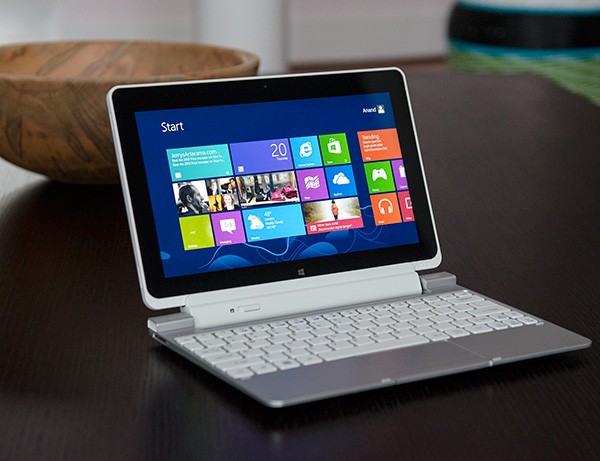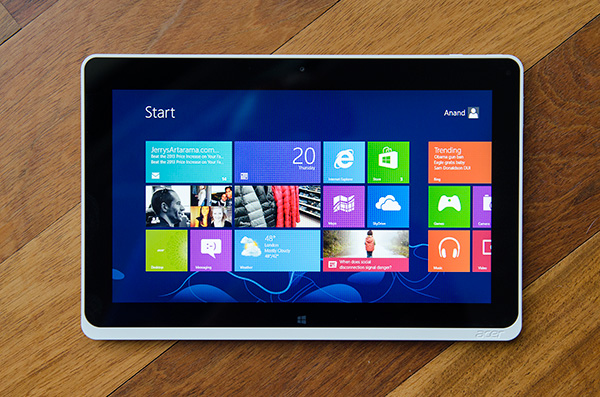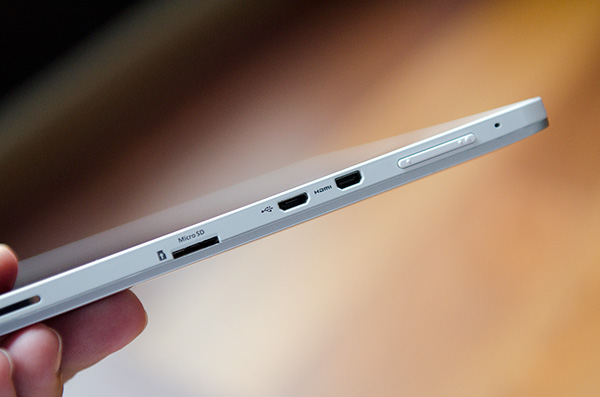The Clover Trail (Atom Z2760) Review: Acer's W510 Tested
by Anand Lal Shimpi on December 20, 2012 10:34 AM ESTMicrosoft’s Windows 8/RT launch has been a bit choppier than expected. I remember hearing rumors that the OS release could slip into next year, but it seems that the solution to the problem was to launch as devices were ready rather than delay everything. Surface was among the first out of the gate, and I was generally pleased with the tablet, but Microsoft’s partner devices have been slower to release. ASUS held its VivoTab RT launch on the same day as Surface RT, but there were many key absences from the launch week in late October.
Among those missing from launch week were any x86 Windows 8 tablets. Although for most of the year Intel had been quite confident in its Windows 8 tablet story, the fact that I had to secretly borrow one just to get some rough performance numbers in our Surface RT story was a problem.
A little over a month later and things are beginning to change. Contrary to popular belief, driver problems aren’t what kept the first Atom Windows 8 tablets out of the market at launch. A bug (not related to power management) caught several months ago caused schedules to slip by about a month and a half. Depending on whose design the OEM followed (Intel’s or their own), the implementation of the fix could come quickly or would take a bit longer. In this case, Acer and Samsung found themselves on the right side of the fence. We’ve had Atom based Windows 8 tablets from both companies for weeks now. Vivek is working on our review of the Samsung ATIV Smart PC, while I’ll kick things off with Acer’s Iconia W510.
The W510 features Intel’s Atom Z2760, the SoC more commonly associated with the codename Clover Trail. While Intel’s Core series of CPUs will be used in high-end Ultrabooks, tablets and convertibles, doing battle at the lower price points against ARM is the Z2760/Clover Trail. Down here, Intel promises all of the power efficiency of ARM, similar pricing, better performance and of course backwards compatibility with older Windows applications.
Although Intel has largely lost the advantage x86 compatibility promised to bring to the smartphone space years ago, that advantage is alive and well under Windows. With Windows RT devices, Microsoft has the somewhat difficult job of explaining that your brand new Windows device won’t run older Windows applications. For an Atom based Windows 8 platform however, that caveat just isn’t there. Meanwhile you get all of the benefits of a Windows RT device, including connected standby - a feature that won’t be present on Core based Windows 8 tablets until Haswell rolls around in the second half of 2013.
Acer’s W510 is a 10-inch Windows 8 tablet designed to compete in a market crowded by ARM based solutions running Android, iOS and Windows RT. Backwards compatibility with decades of x86 applications is a clear point of differentiation.
The W510 is available in two different capacities: 32GB and 64GB. Acer sent along a 64GB version, which is divided into a 46.6GB user partition and 11.05GB recovery partition. Of that 46.6GB that you get to begin with, nearly 13GB is taken up by Windows, leaving you around 30GB free to begin with. This isn’t anything unusual for folks buying a Mac or PC, but if you’re comparing to lightweight mobile OSes you’re going to end up with substantially less usable storage than is advertised.
While Microsoft has definitely help cut down on the amount of bloatware installed on Windows 8 systems from the factory, there are still some culprits. Acer ships McAfee Internet Security trial-ware on the W510 by default). Spotify comes pre-loaded on the machine, as are direct links to Amazon and Ebay for some reason. The tradeoff in buying a Windows 8 tablet instead of an ARM based Windows RT tablet is that you don’t get Office Student/Home Edition 2013 for free. Acer makes it easy for you to get an Office 2010 trial, but that’s about it.
| Tablet Specification Comparison | ||||||||
| Acer W510 | Apple iPad 4 | Google Nexus 10 | Microsoft Surface RT | Samsung Ativ Smart PC | ||||
| Dimensions | 10.2 x 6.6 x 0.3" | 9.5 x 7.31 x 0.37" | 10.39 x 6.99 x 0.35" | 10.81 x 6.77 x 0.37" | 11.97 x 7.46 x 0.39" | |||
| Display | 10.1-inch 1366 x 768 IPS | 9.7-inch 2048 x 1536 IPS | 10.1-inch 2560 x 1600 PLS | 10.6-inch 1366 x 768 PLS | 11.6-inch 1366 x 768 PLS | |||
| Weight | 1.27 lbs | 1.44 lbs (WiFi) | 1.33 lbs | 1.5 lbs | 1.64 lbs | |||
| Processor | Intel Atom Z2760 (2 x 1.8GHz Atom, PowerVR SGX 545) |
Apple A6X (2 x Swift, PowerVR SGX 554MP4) |
Samsung Exynos 5 Dual |
NVIDIA Tegra 3 |
Intel Atom Z2760 (2 x 1.8GHz Atom, PowerVR SGX 545) | |||
| Connectivity | WiFi | WiFi , Optional 4G LTE | WiFi | WiFi | WiFi , Optional 4G LTE | |||
| Memory | 2GB | 1GB | 2GB | 2GB | 2GB | |||
| Storage | 32-64GB | 16GB—64GB | 16GB or 32GB | 32GB or 64GB | 64GB | |||
| Battery | 27.0Wh | 42.5Wh | 33.75Wh | 31.5Wh | 30.0Wh | |||
| Starting Price | $499 | $499 | $399 | $499 | $599 | |||
Although the official MSRP of the W510 is $599, you’ll find the 32GB model at $499 and the 64GB model will set you back another $50 on top of that. Each capacity is available as a standalone tablet or bundled with the keyboard dock.
Like Microsoft’s Touch/Type Covers for Surface, the W510’s keyboard dock isn’t cheap. Acer lists the dock at $150, and that’s roughly what I’ve seen it cost online as well. Acer will sell you the dock separately through its online store but I haven’t seen it widely available elsewhere (as of writing this the dock is out of stock at Acer as well).
Design & Build Quality
I’ve been saying this a lot privately, but Acer’s recent transformation reminds me a lot of HTC. From a design standpoint, the products Acer was putting out two years ago look absolutely nothing like what it’s shipping today. Design is now a priority at Acer, and it shows.
The W510 is all plastic and glass, but it doesn’t feel cheap. The back is an aluminum colored plastic that looks good and feels durable. Around the edge is a nice looking white plastic border and up front there’s the usual bezel and glass treatment. The result is a black frame with white border aesthetic that isn’t fundamentally new, but surprisingly rare in modern tablets.
There is a hint of flex in the chassis that’s barely enough to make a creaking sound if you try and flex the W510 at its corners. Where the back and border plastics meet isn’t particularly well engineered either – the two meet in a relatively neat fashion but run your finger along the border and you’ll feel the unevenness of the levels they meet at. None of these things are deal breakers, but Acer is playing in a different league now – with much higher standards.
The W510 is a fairly light device, at least for a 10-inch tablet. At 1.3 lbs it’s lighter than the big iPad, Surface and the Nexus 10. The weight (or lack thereof) is immediately noticeable, and makes carrying the W510 a pleasure. The 16:9 aspect ratio of the tablet isn’t the most natural unfortunately. Despite the light weight, the W510 ends up feeling a bit long as a result. There’s nothing that can be done about that unfortunately.
Optimizing around 16:9 delivers a much better video viewing and multitasking experience, at the expense of pretty much ruining portrait mode aspirations and making for a slightly awkward in-hand feel.
As the W510 is a Windows 8 tablet, it comes full of IO around the edges. On the right edge there are micro HDMI, micro USB and micro SD slots. The trio of micro IO ports are joined by a volume rocker. Up top there’s the usual 1/8” headphone jack, rotation lock slider and power/lock button. Acer’s proprietary dock/charging connector is at the bottom of the tablet.



















104 Comments
View All Comments
strangis - Thursday, December 20, 2012 - link
"Which means nothing, as these mobile chips are too underpowered to actually run the desktop x86 applications"My ATIV 500 painting an 11x17 300dpi multilayer image in Sketchbook Pro with the active digitizer smoothly disagrees with your assumption.
Just saying.
Wolfpup - Thursday, January 3, 2013 - link
Of COURSE they run desktop programs. They run Firefox, OpenOffice (and older versions of MS Office you might already own), media tools, IM clients, all SORTS of things that aren't available or even possible on other platforms.No, it won't reasonably run Skyrim, but there's a ton that it will run.
Personally I think this is pretty awesome...you get a good for the form factor CPU that oh yeah, happens to actually be compatible with what you have, and the price is the same as ARM stuff.
What's bad is the GPU...seems like they have almost a 2009 smartphone GPU in there rather than something more appropriate for 2013...and then there's the issue that metro is locked down, not a real PC...but then that's why you want an x86 tablet to begin with...at least you get the real desktop and in that mode it's a real PC.
jeffkro - Thursday, December 20, 2012 - link
Basically for tablets and phones I prefer the android "library" so intel/windows really isn't for me anyways.SM123456 - Wednesday, February 13, 2013 - link
Yes, but Microsoft has to use a x86 CPU if they are to be able run Windows apps.Basically this device and all other Windows 8 tablets under $600 are grossly overpriced netbooks with touch added and a keyboard taken away.
The $199 Acer C7 Chromebook with its 1.1 GHz dual core Celeron processor is at least twice as fast as this thing.
Dribble - Thursday, December 20, 2012 - link
So we have windows RT that is optimised both around the ARM cpu's and tablets. There is no old software - everything that you can get for it should both run fine on tegra 3 and work well with a small touch screen. This means stuff should just work well - this is what apple do so well, and MS are trying to emulate.On the other hand there is full windows. Now the reason to get this not RT is backwards compatibility. Most *old* windows apps require higher performance cpu's (e.g core i3) a big screen, a mouse and a keyboard. They don't use touch at all.
Taking that into account an atom tablet has a screen that's too small, a cpu that's too slow and a bad mouse/keyboard experience - sure you could plug both in but then it's not really a tablet any longer is it? Also all that backward compatibility support uses effectively a different ui - it's not a clean and polished single interface. Stuff won't just work well - the experience won't be as good.
Hence if you want full windows you'd be much better off with a laptop/ultra book - they are still touch screen so you get any touch benefits but they have much faster cpu's, better keyboard, etc.
Shadowmaster625 - Thursday, December 20, 2012 - link
Not sure where you got that idea from. 99% of windows applications dont hardly use any cpu at all. Check task manager sometime. You will notice that most processes only consume a few seconds of cpu time per hour of system idle time. It is extremely rare for a windows application to peg even one cpu core to 100%.freedom4556 - Thursday, December 20, 2012 - link
You that that's a percentage and it depends on what CPU you're looking at right? That's like saying, "Yeah, I never need more than 1% of my horsepower even doing 150mph uphill in a headwind." when you drive a Lamborghini. Try it again in a Honda and you'll not even be able to do it, nevermind 100% usage.Do you have an i7 or an Atom?
B3an - Thursday, December 20, 2012 - link
One thing that stood out to me in this article, is the bugs/reboots you encountered. You pretty much blamed them on Win 8, or made it sound that way. Which i thought was unprofessional, especially for you Anand. As theres a very good chance they're to do with a particular app, drivers on this device, or even it's hardware. Win 8 is a very solid stable OS, even more so than Win 7 on release.ltcommanderdata - Thursday, December 20, 2012 - link
True. But hasn't it always been the case that app and driver instability gets fairly or unfairly associated with Windows? At the same time, when things are working well, Microsoft is happy if you think of yourself as enjoying a "Windows" PC or tablet regardless of what particular software or hardware you are using in/on Windows. I guess we'll have to see how common problems are with other CloverTrail tablets. If they show up in CloverTrail tablets from other manufacturers, then even if the underlying OS is stable it still becomes Microsoft's problem if people are having trouble developing reliable apps/drivers/tablet using it.Anand Lal Shimpi - Thursday, December 20, 2012 - link
The issue is these were first party apps developed by MS, and I've seen some evidence of the same on other non-W510 platforms (I just don't remember this being the case with Surface RT but I've been using these x86 platforms longer than I did Surface).I'm curious to read Vivek's take on the ATIV Smart PC to see if it mirrors my experience.
Take care,
Anand